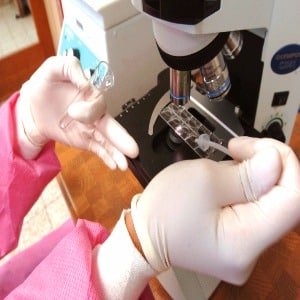The content of epithelial cells in urine is one of the measures that are part of the urinary sediment analysis . This information, combined with other data from urinalysis and the patient’s symptoms, is useful in many cases to be able to make a correct diagnosis .
Epithelial cells are cells of the epithelial tissue , the tissue that covers the surfaces of the body, both external and internal cavities and ducts such as the renal tubules, ureters, urinary bladder and urethra. Old epithelial cells are released from the epithelium and replaced by new cells so they can be found in the urine under normal conditions . In men they are usually scarce and in women the normal amount is more variable depending on the stage of the menstrual cycle.
In any case, a high number of epithelial cells in the urine is a sign that something may be happening. The most frequent causes are infectious processes and inflammation of the urinary tract.
Epithelial cells in urine are determined by microscopic examination of the urine sediment. Urine sediment is obtained by centrifugation of the urine. During centrifugation, the suspended solid elements fall to the bottom forming a sediment that can be easily separated from the liquid fraction for study.
In addition to the presence of epithelial cells, the presence of bacteria and other microorganisms, blood cells (red blood cells, leukocytes), crystals (uric acid, cystine, oxalic acid), proteins, etc. are also studied in the urinary sediment.
Table of Contents
Types of epithelial cells in urine and their meaning
In general, a low number of epithelial cells is of no importance but if they are in high quantity it is important to determine what type they are and their concentration . In the urine, three types of epithelial cells can be found: squamous or flat, transitional and tubular cells of the renal epithelium.
Squamous Cells
Also called flat cells due to their shape, they are thin cells coming mainly from the vaginal epithelium or the distal urethral epithelium and are common in the urine in low quantity. A high content in squamous epithelial cells is indicative of a possible vaginitis or urethritis . This type of cells is also found in the epithelium of the genitals outside the body, so that their presence in high numbers may be due to contamination or incorrect collection of the sample.
When a high number of squamous cells is found in urine, a new sample is usually requested to compare the results with emphasis on collection rules and instructions that minimize the risk of contamination.
Transitional cells
They come from the epithelium that covers the proximal urethra and the bladder. It is associated with inflammatory processes , usually related to infections . A high number of transitional cells are also observed in patients with renal lithiasis .
Renal tubular cells
They are the cells that cover the renal tubules (part of the nephron) and in normal conditions do not appear in urine . Its presence is related to kidney damage such as acute tubular necrosis, some viral diseases (such as cytomegalovirus nephritis), pyelonephritis, rejection of transplants and toxic reactions to certain substances. Those known as fatty oval bodies are these same lipid-laden cells that appear in the nephritic syndrome .
When tubular cells appear in the urine, it is common for more tests to be ordered and a renal profile is done to find out what is happening in the kidney and to be able to give a specific differential diagnosis.
References
- Giovanni B. Fogazzi (2010). The urinary sediment. An integrated view . Elsevier. ISBN: 9788821430169.
- Urinary Cylinders on MedLinePlus



